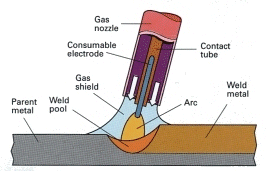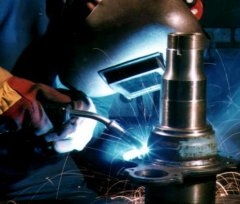Post by Mnikolic on Jul 3, 2020 19:29:57 GMT 1
Metal Inert Gas Welding
MIG welding is a gas metal arc welding (GMAW) process that uses a continuous solid wire electrode which is heated and fed into the weld pool from a welding gun. The two base materials are melted together forming a join. The welding gun feeds a shielding gas alongside the electrode, which helps protect the weld pool from airborne contaminants.
Metal Inert Gas (MIG) welding was first patented in the USA in 1949 for welding aluminium. The arc and weld pool formed using a bare wire electrode was protected by helium gas, readily available at that time. From about 1952, the process became popular in the UK for welding aluminium using argon as the shielding gas, and for carbon steels using CO2. CO2 and argon-CO2 mixtures are known as metal active gas (MAG) processes. MIG is an attractive alternative to MMA, offering high deposition rates and high productivity.,
Process Characteristics

MIG/MAG welding is a versatile technique suitable for both thin sheet and thick section components. An arc is struck between the end of a wire electrode and the workpiece, melting both of them to form a weld pool. The wire serves as both heat source (via the arc at the wire tip) and filler metal for the welding joint. The wire is fed through a copper contact tube (contact tip) which conducts welding current into the wire. The weld pool is protected from the surrounding atmosphere by a shielding gas fed through a nozzle surrounding the wire. Shielding gas selection depends on the material being welded and the application. The wire is fed from a reel by a motor drive, and the welder moves the welding torch along the joint line. Wires may be solid (simple drawn wires), or cored (composites formed from a metal sheath with a powdered flux or metal filling). Consumables are generally competitively priced compared with those for other processes. The process offers high productivity, as the wire is continuously fed.
Manual MIG/MAG welding is often referred as a semi-automatic process, as the wire feed rate and arc length are controlled by the power source, but the travel speed and wire position are under manual control. The process can also be mechanised when all the process parameters are not directly controlled by a welder, but might still require manual adjustment during welding. When no manual intervention is needed during welding, the process can be referred to as automatic.
The process usually operates with the wire positively charged and connected to a power source delivering a constant voltage. Selection of wire diameter (usually between 0.6 and 1.6mm) and wire feed speed determine the welding current, as the burn-off rate of the wire will form an equilibrium with the feed speed.
Metal Transfer Mode
The manner, or mode, in which the metal transfers from the electrode to the weld pool largely determines the operating features of the process. There are three principal metal transfer modes:
- Short circuiting/ Dip
- Droplet / spray
- Pulsed
Short-circuiting and pulsed metal transfer are used for low current operation while spray metal transfer is only used with high welding currents. In short-circuiting or 'dip' transfer, the molten metal forming on the tip of the wire is transferred by the wire dipping into the weld pool. This is achieved by setting a low voltage; for a 1.2mm diameter wire, arc voltage varies from about 17V (100A) to 22V (200A). Care in setting the voltage and the inductance in relation to the wire feed speed is essential to minimise spatter. Inductance is used to control the surge in current which occurs when the wire dips into the weld pool.
For droplet or spray transfer, a much higher voltage is necessary to ensure that the wire does not make contact i.e. short-circuit, with the weld pool; for a 1.2mm diameter wire, the arc voltage varies from approximately 27V (250A) to 35V (400A). The molten metal at the tip of the wire transfers to the weld pool in the form of a spray of small droplets (about the diameter of the wire and smaller). However, there is a minimum current level, threshold, below which droplets are not forcibly projected across the arc. If an open arc technique is attempted much below the threshold current level, the low arc forces would be insufficient to prevent large droplets forming at the tip of the wire. These droplets would transfer erratically across the arc under normal gravitational forces. The pulsed mode was developed as a means of stabilising the open arc at low current levels i.e. below the threshold level, to avoid short-circuiting and spatter. Metal transfer is achieved by applying pulses of current, each pulse having sufficient force to detach a droplet. Synergic pulsed MIG refers to a special type of controller which enables the power source to be tuned (pulse parameters) for the wire composition and diameter, and the pulse frequency to be set according to the wire feed speed.

Shielding Gas
In addition to general shielding of the arc and the weld pool, the shielding gas performs a number of important functions:
- forms the arc plasma
- stabilises the arc roots on the material surface
- ensures smooth transfer of molten droplets from the wire to the weld pool
Thus, the shielding gas will have a substantial effect on the stability of the arc and metal transfer and the behaviour of the weld pool, in particular, its penetration. General purpose shielding gases for MIG welding are mixtures of argon, oxygen and CO2, and special gas mixtures may contain helium. The gases which are normally used for the various materials are:
Steels:
- CO2
- argon +2 to 5% oxygen
- argon +5 to 25% CO2
Non-ferrous (e.g. Aluminium, copper or nickel alloys):
- argon
- argon/helium
Argon based gases, compared with CO2, are generally more tolerant to parameter settings and generate lower spatter levels with the dip transfer mode. However, there is a greater risk of lack of fusion defects because these gases are colder. As CO2 cannot be used in the open arc (pulsed or spray transfer) modes due to high back-plasma forces, argon based gases containing oxygen or CO2 are normally employed.
Applications:
MIG/MAG is widely used in most industry sectors and accounts for more than 50% of all weld metal deposited. Compared to MMA, MIG/MAG has the advantage in terms of flexibility, deposition rates and suitability for mechanisation. However, it should be noted that while MIG/MAG is ideal for 'squirting' metal, a high degree of manipulative skill is demanded of the MIG welder.
/////////////////////////////////////////////
This article was copied from the www.twi-global.com/. No copyright infirigment intended. Credits go to the creators of the original article on the original website. This thread has been posted for informational purposes only.

